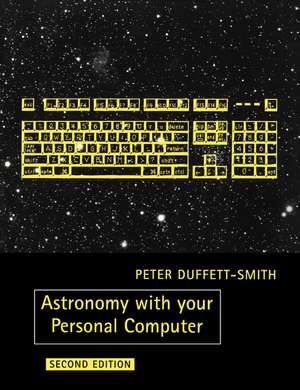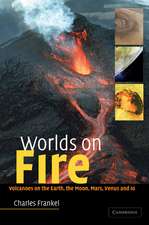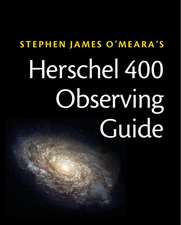Astronomy with your Personal Computer
Autor Peter Duffett-Smithen Limba Engleză Paperback – 28 iun 1990
Preț: 377.38 lei
Nou
Puncte Express: 566
Preț estimativ în valută:
72.21€ • 75.39$ • 59.76£
72.21€ • 75.39$ • 59.76£
Carte tipărită la comandă
Livrare economică 05-19 aprilie
Preluare comenzi: 021 569.72.76
Specificații
ISBN-13: 9780521389952
ISBN-10: 052138995X
Pagini: 272
Ilustrații: 2 half-tones, 2 tables, 8 line diagrams
Dimensiuni: 195 x 243 x 24 mm
Greutate: 0.49 kg
Ediția:Revizuită
Editura: Cambridge University Press
Colecția Cambridge University Press
Locul publicării:Cambridge, United Kingdom
ISBN-10: 052138995X
Pagini: 272
Ilustrații: 2 half-tones, 2 tables, 8 line diagrams
Dimensiuni: 195 x 243 x 24 mm
Greutate: 0.49 kg
Ediția:Revizuită
Editura: Cambridge University Press
Colecția Cambridge University Press
Locul publicării:Cambridge, United Kingdom
Cuprins
Preface; Using your personal computer for astronomy; Default value input routine; 'Y' or 'N' input routine MINSEC converts between decimal hours/degrees and min/sec form; JULDAY calendar date to Julian day number since 1900 Jan. 0.5; CALDAY Julian day number since 1900 Jan. 0.5 to calendar date; TIME converts between local civil and sidereal times; EQHOR converts between equatorial and horizon coordinates; HRANG converts between right ascension and hour-angle; OBLIQ calculates the value of the obliquity of the ecliptic; NUTAT finds corrections for nutation in longitude and obliquity; EQECL converts between equatorial and ecliptic coordinates; EQGAL converts between equatorial and galactic coordinates; GENCON converts between any of the coordinate systems; PRCESS1 approximate precession of equatorial coordinates; PRCESS2 rigorous precession of equatorial coordinates; PARALLX converts between geocentric and apparent position; REFRACT calculates the effect of atmospheric refraction; RISET finds the circumstances of rising and setting; ANOMALY solves Kepler's equation for elliptical motion; SUN finds the ecliptic coordinates of the Sun; SUNRS finds the circumstances of sunrise and sunset; PELMENT returns the orbital elements of the major planets; PLANS finds the position of a planet; MOON finds the position and parallax of the Moon; MOONRS finds the circumstances of moonrise and moonset; MOONNF finds the times of new and full moon; ECLIPSE finds the circumstances of lunar and solar eclipses; Displays an eclipse in graphical form; ELOSC finds positions from osculating elliptical elements; RELEM converts ecliptic orbital elements from one epoch to another; PCOMET finds the position of a comet from parabolic elements; PFIT finds parabolic elements from observations; EFIT finds elliptical elements from observations; List of variables; Bibliography; Index.
Recenzii
"This is a work which all amateur astronomers will want to possess." Times Higher Education Supplement
"This is one of the best publications of its type on the market today. The book is well written and illustrated. It is highly recommended." Journal of the Association of Lunar and Planetary Observers
"...an example of how wonderful a tool a computer and a few programs can be. With the subroutines in this book, the amateur astronomer can have more time to concentrate on the heavens and leave the earthly work of astronomical computations to the computer....a good sourcebook for those amateur astronomers who are not afraid of some simple programming or for getting someone who is familiar with programming interested in astronomy. It could be useful to those who want more accuracy in their space games." William H. MacIntosh, Computing Reviews
"This is one of the best publications of its type on the market today. The book is well written and illustrated. It is highly recommended." Journal of the Association of Lunar and Planetary Observers
"...an example of how wonderful a tool a computer and a few programs can be. With the subroutines in this book, the amateur astronomer can have more time to concentrate on the heavens and leave the earthly work of astronomical computations to the computer....a good sourcebook for those amateur astronomers who are not afraid of some simple programming or for getting someone who is familiar with programming interested in astronomy. It could be useful to those who want more accuracy in their space games." William H. MacIntosh, Computing Reviews









